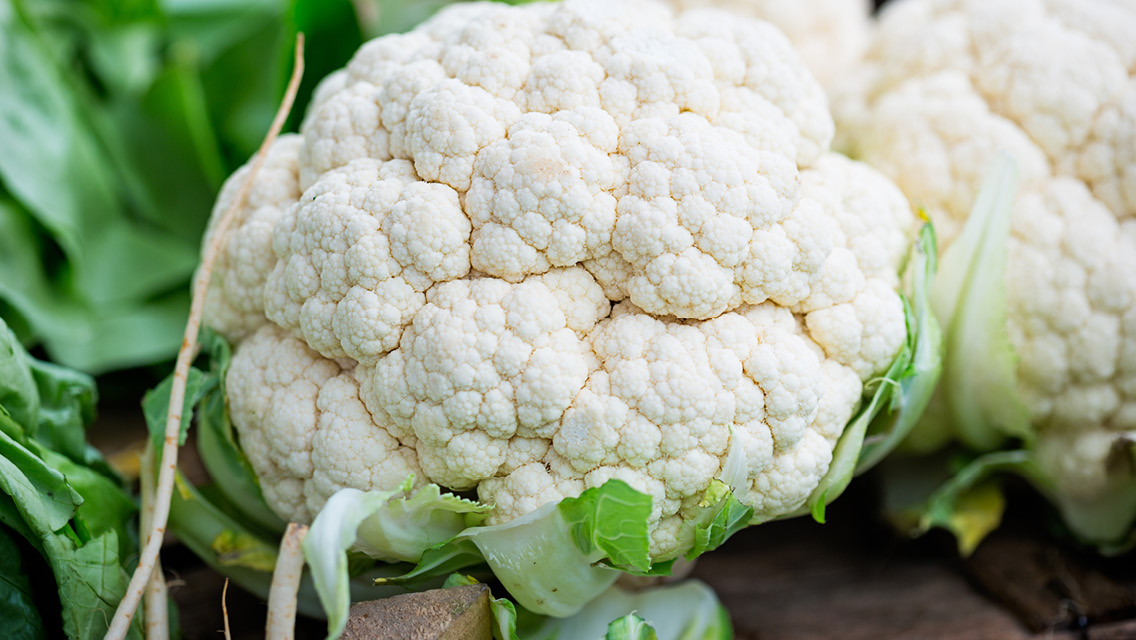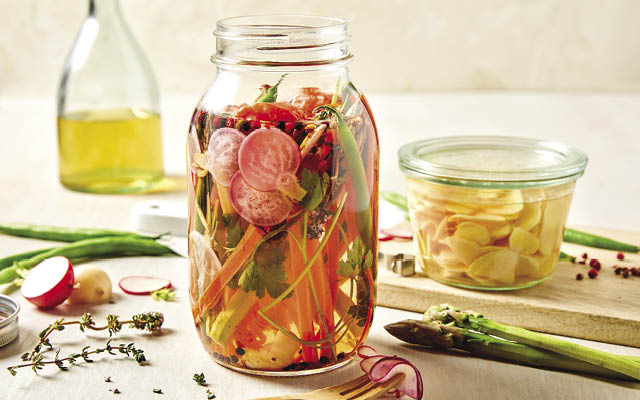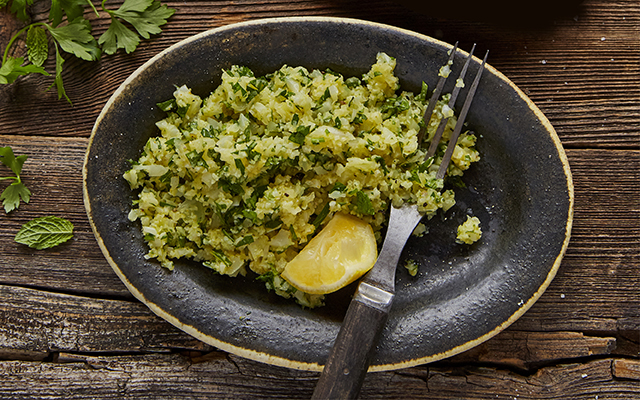Cauliflower is often relegated to the veggies-and-dip tray, but this nutritional powerhouse deserves a place of honor at every dinner table. Raw or roasted, steamed or sautéed, it can be incorporated into delicious dishes that please the palate while promoting vibrant health.
Food Basics
Cauliflower is a cruciferous vegetable with a mild, slightly nutty flavor. White cauliflower is the most readily available in grocery stores, but there are also green, orange and purple varieties. Green cauliflower — a cross between cauliflower and broccoli — is slightly sweeter than white cauliflower when raw and tastes more like broccoli when steamed. The orange variety is also slightly sweeter than white cauliflower, and the purple variety has a milder flavor. Purple cauliflower cooks a little faster than its white cousin and turns green when heated. When purchasing, look for firm cauliflower with compact florets. The leaves should be green and crisp.
Nutritional Know-How
Cauliflower contains glucosinolates and thiocyanates — both sulfur-containing phytonutrients — that cleanse the body of damaging free radicals. These phytonutrients encourage the body to ramp up its production of enzymes that aid in detoxification and even kill some tumors and cancer cells. Studies have shown that eating three to five servings of cruciferous vegetables each week can significantly lower the risk of several types of cancer. Researchers believe that, when combined with turmeric, cauliflower may help prevent (or stop the spread of) prostate cancer. Orange cauliflower has slightly higher levels of beta-carotene, and purple cauliflower contains the flavonoid anthocyanin, a powerful antioxidant. A 1-cup serving of boiled cauliflower contains a whopping 91.5 percent of the recommended daily value of vitamin C.
Eat Up!
Cauliflower can be eaten raw, and steamed, sautéed, stir-fried, fried, boiled or roasted. You can cook the cauliflower as a whole head or cut into florets.
- Cauliflower is uncommonly delicious when roasted. Cut one head into small, even florets. Toss them with olive oil, salt, pepper and dried red pepper to taste; or toss with olive oil, 1/4-cup soy sauce and a dash of pepper. Place in a single layer on a baking tray and cook at 450 degrees F for 20 minutes or until golden around the edges.
- Chop raw cauliflower into different sizes and add it to salads. Add small florets to your favorite bean salad for extra crunch.
- To add texture to your next stir-fry dish, cut the whole cauliflower into 1/2-inch slices, break into florets and stir-fry according to your favorite recipe. Flat slices of cauliflower cook quickly and have more surface area for the sauce to cling to.
Kitchen Tricks
- Fix quick, healthy snacks by preparing cauliflower as soon as you bring it home from the store. Clean and cut into florets, then store in a plastic bag in the refrigerator for up to four days.
- To clean, remove the leaves and gently scrape off any brown spots with a knife. Place the cauliflower upside down on a cutting board and carefully cut around and remove the core that keeps the florets intact.
- Avoid cooking cauliflower in aluminum or iron pots. When chemical compounds in cauliflower come in contact with aluminum, the vegetable will yellow. When they come in contact with iron, cauliflower turns brown or blue-green.
Cauliflower Purée
Makes six servings
- 2 1/4 lbs cauliflower florets
- 1 1/2 cups whole milk, to cover
- 1 tbs. minced fresh thyme
- 1/4 tsp. sea salt
- 1/4 cup Parmesan cheese, shaved
Directions
- Place the cauliflower, milk and thyme in a medium sauce pan and bring to a simmer; reduce heat to low and cook for approximately 15 to 20 minutes or until cauliflower is soft.
- Carefully ladle the cauliflower florets into the blender in batches and purée until very smooth. Add only enough of the skim milk to allow the blades to turn and purée cauliflower until smooth.
- Add Parmesan cheese. Season to taste with salt.
Per serving (1/2 cup): Calories 70; protein 5 g; total fat 3.5 g; saturated fat 2.5 g; carbohydrates 6 g; dietary fiber 1 g; cholesterol 15 mg; sodium 230 mg
Curried Cauliflower Salad
Makes eight servings
- 1 head of cauliflower, broken into florets
- 1 tbs. curry powder
- 1 tsp. extra-virgin olive oil
- 1 tbs. seasoned rice wine vinegar
- 1 cup julienned red peppers
- 1 cup baked tofu, sliced into thin strips
- 2 tbs. seasoned rice wine vinegar
- 1/4 tsp. sea salt
- 1/4 tsp. freshly ground black pepper
Directions
Preheat oven to 350 F (175 C). In a mixing bowl, combine the cauliflower, curry powder, olive oil and 1 tablespoon of rice wine vinegar. Place on a baking sheet and bake for 10 minutes or until the cauliflower is just starting to soften. Cool on rack for about 10 minutes. In a mixing bowl, combine the cauliflower, red peppers and tofu. Mix in remaining 1 tablespoon rice wine vinegar, salt and pepper. Refrigerate for at least 30 minutes prior to serving.
Per serving (1 cup): Calories 70; protein 6 g; total fat 3 g; saturated fat 0 g; carbohydrates 6 g; dietary fiber 2 g; cholesterol 0 mg; sodium 90 mg
Cauliflower Soup
Makes 8 cups
- 1/4 tsp. olive oil
- 1 cup diced onion
- 1/2 cup diced celery
- 1 tsp. minced fresh garlic
- 4 cups cauliflower florets and stems
- 2 cups diced Yukon Gold potatoes
- 2 tsp. dried thyme
- 1 bay leaf
- 1/4 tsp. sea salt
- 1/2 tsp. freshly ground black pepper
- 1/4 tsp. nutmeg
- 2 quarts vegetable stock
Directions
- Heat a large stockpot over high heat and add olive oil.
- Stir in the onions, celery, garlic and cauliflower. Sauté until the onions are translucent, about three to five minutes.
- Stir in the potatoes, spices and vegetable stock. Bring to a boil; reduce heat and simmer until potatoes and cauliflower are tender.
- Transfer to blender or food processor and blend until smooth.
- Season with salt, pepper and nutmeg.
Per 1-cup serving: Calories 80; protein 3 g; total fat 0.5 g; saturated fat 0 g; carbohydrates 18 g; dietary fiber 4 g; cholesterol 0 mg; sodium 115 mg
Pickled Cauliflower
Makes about 5 cups
For pickling liquid:
- 1 1/4 cups white wine vinegar
- 1 1/2 cups water
- 1/3 cup honey
- 1 1/2 tbs. kosher salt 1/2 tsp. yellow mustard seeds
- 1/4 cup fresh dill sprigs (1½ tablespoons dried dill) 1 bay leaf
- 1 1/2 tsp. pickling spice
- 1 tsp. garlic powder
- 1/4 tsp. dried hot red-pepper flakes
For vegetables:
- 2 heads cauliflower (2 lbs.) trimmed and broken into 1- to 1 1/2-inch florets (6 cups)
Directions
- To prepare pickling liquid: Bring pickling-liquid ingredients to a boil in a 3-quart nonreactive saucepan over moderate heat, stirring until honey is dissolved. Add the cauliflower and simmer for 10 minutes.
- Remove pan from heat and carefully take cauliflower out of pickling liquid.
- Place the cauliflower in a sterilized container and cover cauliflower with pickling liquid.
- Use a small plate to weigh down the cauliflower and keep it submerged.
- Chill, covered, at least one day before serving.
Per serving (1/4 cup): Calories 45; protein 1 g; total fat 0 g; saturated fat 0 g; carbohydrates 10 g; dietary fiber 2 g; cholesterol 0 mg; sodium 710 mg
Recipes presented by Conscious Cuisine.




This Post Has 0 Comments